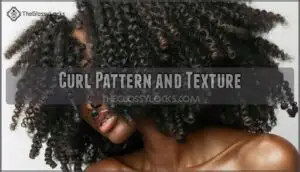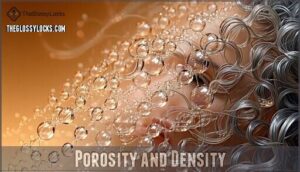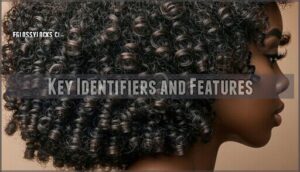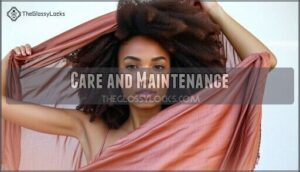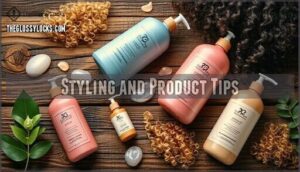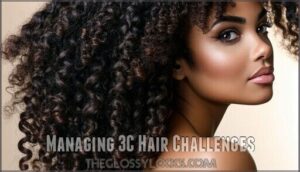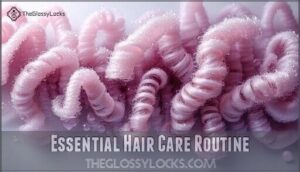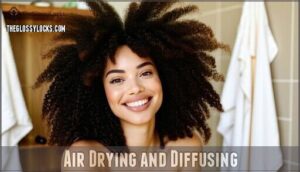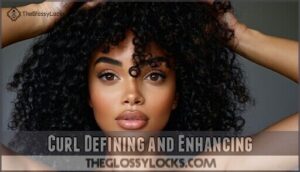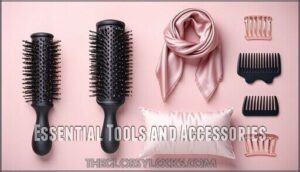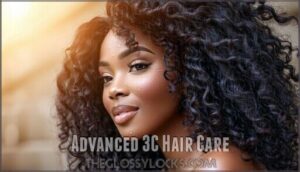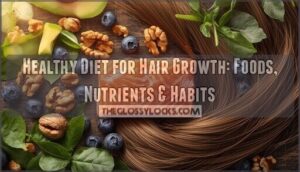This site is supported by our readers. We may earn a commission, at no cost to you, if you purchase through links.
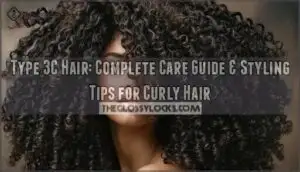
You’ll notice your curls pack serious volume, shrink dramatically when dry, and crave moisture more than other curl patterns.
This hair type sits between curly and coily, creating dense texture that’s prone to dryness and tangles.
Your strands likely feel coarse but aren’t necessarily thick, and they’ll shrink up to 75% of their actual length.
Type 3c hair responds best to cream-based products, gentle detangling when wet, and protective styling methods.
The secret lies in understanding your hair’s unique moisture needs and porosity levels.
Table Of Contents
Key Takeaways
- You’ll recognize your type 3c hair by its tight corkscrew curls that spring back when stretched, creating dense, voluminous texture that shrinks up to 75% when dry and sits between curly and coily patterns.
- Your hair craves consistent moisture through weekly deep conditioning, sulfate-free products, and cream-based styling products since the tight curl structure makes it prone to dryness and breakage.
- You’ll get the best results by detangling gently when wet with conditioner, using the praying hands method or scrunching techniques for definition, and protecting your curls at night with silk or satin materials.
- Your styling success depends on working with your hair’s natural pattern rather than against it, using leave-in conditioners followed by curl creams, and avoiding touching dry curls to prevent frizz and maintain definition.
Type 3C Hair Overview
You’ve got type 3C hair if your curls form tight, springy corkscrews that bounce back when you stretch them, creating a dense, voluminous texture that’s coarser than other curl types.
This hair type sits at the boundary between curly and coily textures, featuring defined S-shaped patterns that are smaller in circumference than 3B curls but wider than 4A coils.
Hair Typing Systems
Understanding hair typing systems helps you decode your curl pattern like a roadmap to better care.
Andre Walker’s popular system classifies hair into four main types, with type 3c hair falling into the curly category.
System comparison reveals limitations in typing accuracy, as emerging systems address cultural impact and individual variations that traditional hair classification methods often miss, highlighting the need for a more nuanced approach to understand one’s hair typing.
Characteristics and Identification
You’ll spot type 3c hair by its tight corkscrew curls that spring back when stretched.
These curls showcase distinct S/Z patterns with a pencil-thick curl circumference. Your hair density appears thick and voluminous, while strand thickness varies from fine to coarse.
Volume assessment reveals impressive root lift that makes your curls stand out. Hair typing charts place 3c between loose curls and coily textures.
Due to its structure, 3C hair often exhibits characteristics of low porosity, which can be understood through hair typing charts and recognizing low porosity.
Comparison to Other Hair Types
Your type 3c hair sits right between 3B and 4A on hair typing systems.
While 3B features looser, medium-sized curls, your 3C curls pack tighter with smaller curl circumference.
Compared to 4A’s coily characteristics and Z-shaped curls, your hair texture maintains more defined S-patterns.
This unique curl pattern combines curly and coily traits, making 3C hair types distinctly springy, with a mix of curly and coily characteristics.
3C Hair Characteristics
Your 3C hair features tight, springy corkscrews that form distinct S or Z-shaped patterns, creating volume and texture that’s denser than looser curl types.
You’ll notice your curls have a coarse feel, pack tightly together, and shrink substantially when dry, making your hair appear shorter than its actual length due to the substantial shrinkage.
Curl Pattern and Texture
Your 3c hair features tight corkscrew curls with distinct S-shaped patterns that create natural volume.
Your curls are living springs – tight corkscrews that bounce with life and create effortless, enviable volume.
The strand thickness varies from medium to coarse, giving your curls their characteristic springy texture.
These pattern variations range from loose corkscrews to tighter spirals, while curl elasticity allows your hair to bounce back when stretched.
This unique hair curl definition sets 3C apart from other curl patterns, with natural volume and curl elasticity being key distinguishing features.
Porosity and Density
Your 3c hair’s porosity levels determine how it absorbs moisture, while density types affect overall volume.
Low porosity hair repels water like a raincoat, making product absorption challenging.
High density means tightly packed hair strand sizes, creating thick texture.
Understanding your hair porosity and hair density helps you choose products that actually penetrate and retain moisture effectively.
Many with this hair type experience significant volume and shrinkage when their hair dries.
Key Identifiers and Features
Your type 3c hair stands out with its distinctive S-shaped pattern and tight corkscrew curls.
The curl circumference sits smaller than 3B but wider than 4A hair.
You’ll notice significant hair density and volume, plus texture variations throughout your head.
These curl patterns create natural bounce while hair porosity affects how products absorb into your strands.
Many find that sulfate-free co-washes work best for cleansing and maintaining the health of your type 3c hair.
Care and Maintenance
Your 3C curls need consistent moisture, gentle handling, and protective nighttime care to stay healthy and defined.
You’ll want to focus on regular deep conditioning, careful detangling techniques, and using silk or satin materials to prevent breakage while you sleep, which involves protective care.
Moisturizing and Hydrating
Your 3c hair craves moisture like a thirsty plant needs water.
- Deep conditioning weekly – Use protein-free masks with humectants like glycerin to penetrate stubborn cuticles
- Layer natural oils – Seal moisture with jojoba or argan oil after applying leave-in conditioner
- Try porosity solutions – Steam treatments open cuticles for better product absorption
Detangling and Trimming
Gentle detangling prevents breakage in your type 3c hair.
Always start dry detangling with fingers or wide-tooth combs before washing. Wet detangling works best with conditioner for slip.
Your detangling tools should glide through curls, not fight them.
Regular trimming every 6-8 weeks stops split ends from traveling up your hair shaft, keeping your curls healthy and bouncy.
Protecting Hair at Night
Your 3c hair needs protection while you sleep to prevent breakage and frizz.
Swap cotton pillowcases for silk or satin ones, which reduce friction.
Try the pineapple method by loosely gathering curls at your crown, or wrap hair in silk scarves.
Satin bonnets and silk sleep bonnets work wonders too.
Loose jumbo twists offer another gentle overnight option for maintaining your curl pattern.
Styling and Product Tips
Styling your 3C hair requires the right products and techniques to enhance your natural curl pattern while fighting frizz.
You’ll need to choose curl-defining creams, leave-in conditioners, and styling methods that work with your hair’s unique texture, not against it, to achieve the best results with frizz.
Recommended Hair Styles
Your 3c hair opens doors to countless hairstyles that celebrate your natural texture.
Consider your face shape when choosing cuts – round faces benefit from layered styles, while square faces shine with soft, voluminous looks.
Protective styles like Bantu knots and twist-outs promote styling longevity while minimizing manipulation.
Versatile cuts such as tapered styles and bob cuts showcase your curls beautifully while accommodating different growth patterns.
To boost volume, consider clipping roots for lift.
Product Selection and Application
Building your perfect 3c hair products arsenal starts with smart ingredient analysis and strategic product layering.
You’ll want sulfate-free shampoos, moisture-rich leave-ins, and lightweight styling gels that won’t weigh down your curls.
Your budget-friendly products shopping list:
- Deep conditioning masks with shea butter for weekly moisture treatments
- Leave-in conditioners applied to damp hair using sectioning application techniques
- Natural hair products or DIY recipes mixing oils with curl creams for custom 3c hair styling
Consider using specific 3c leave-ins for best results.
Minimizing Frizz and Maximizing Definition
Product layering helps lock moisture into your 3c hair while fighting frizz.
Start with a leave-in conditioner, add oil for porosity control, then finish with curl cream.
Work products through wet hair in sections to form defined curl clumps.
Avoid touching dry curls – this breaks up your hard work and creates unwanted frizz.
Managing 3C Hair Challenges
While 3C hair offers beautiful, defined curls, you’ll face specific challenges like persistent dryness, stubborn frizz, and significant shrinkage that can make your hair appear much shorter than it actually is.
Understanding these common issues, along with low porosity that makes moisture absorption difficult, helps you tackle each problem with targeted solutions and the right techniques, addressing challenges such as persistent dryness and stubborn frizz.
Dryness and Breakage
Despite your curls’ natural beauty, 3c hair breakage and dryness can feel overwhelming without proper moisture retention strategies.
Low hair porosity makes hydration tricky, but consistent care prevents damage.
Combat dryness with these essentials:
- Deep condition weekly using protein balance treatments
- Practice gentle detangling on wet, conditioned hair only
- Implement protective styling and night protection routines
Your curls thrive when you prioritize consistent 3c hair moisture practices, using proper care to prevent damage.
Frizz and Unruly Texture
Frizz becomes your biggest enemy when humidity hits or product buildup weighs down your 3c hair.
Your curls lose their definition, turning into an unruly mess that defies styling attempts.
| Frizz Causes | Quick Fixes | Prevention Tips |
|---|---|---|
| Humidity Effects | Anti-humidity serum | Sealed cuticles with oils |
| Product Buildup | Clarifying shampoo | Weekly deep cleansing |
| Rough Toweling | Microfiber cloth | Gentle scrunching motion |
| Over-manipulation | Hands-off approach | Style when wet only |
| Heat damage | Protein treatments | Air-dry or diffuse low |
Combat curly hair frizz through proper detangling methods and overnight protection using silk pillowcases.
Shrinkage and Low Porosity
Your 3c hair can shrink up to 50%, making length retention feel impossible.
Low porosity creates moisture barriers that block product penetration, leaving curls thirsty despite your efforts.
Combat shrinkage with gentle stretching techniques and protective styles.
For porosity treatments, use heat or steam to open cuticles, allowing deeper moisture absorption and better curl definition.
To address these issues effectively, it’s crucial to understand the importance of moisture absorption in hair care.
Essential Hair Care Routine
Creating a consistent hair care routine forms the foundation for healthy, defined 3C curls that resist dryness and breakage.
You’ll need to balance gentle cleansing with intensive moisture treatments, using sulfate-free shampoos and weekly deep conditioning masks to maintain your hair’s natural curl pattern and prevent the common issues that plague tightly coiled hair, ensuring healthy hair.
Regular Deep Conditioning
Deep conditioning transforms your 3c hair care routine into a moisture powerhouse.
Apply thick conditioner from ends to roots weekly, leaving it on for 20-30 minutes.
Consider your hair porosity when choosing products – low porosity hair benefits from heat application to open cuticles.
DIY recipes with natural ingredients offer protein balance while maximizing ingredient benefits for ideal hair moisture.
Gentle Shampooing and Conditioning
When washing 3c hair, choose sulfate-free shampoos that won’t strip your natural oils.
Co-washing frequency should be 2-3 times weekly between regular hair washing sessions. Different conditioner types work better for various porosity levels.
Focus on scalp health by massaging gently during shampooing. Monthly clarifying treatments remove product buildup while maintaining your curl’s moisture balance.
A pre-poo treatment can protect hair during cleansing.
Styling Techniques and Tools
You’ll need specific techniques and tools to style your 3C curls without causing damage or losing definition.
The right approach involves mastering air-drying methods, using diffusers properly, and choosing tools that work with your curl pattern rather than against it.
This approach is crucial for maintaining the health and definition of your curls.
Air Drying and Diffusing
Air drying benefits your 3c hair by preventing heat damage while maintaining natural curl patterns.
Choose bowl or sock diffuser types for gentle volume boosting without creating frizz.
Reduce drying time by gently squeezing excess water with a microfiber towel first.
The diffuser’s low heat setting enhances hair definition while protecting delicate curls from harsh manipulation during hair styling sessions, which helps in maintaining the natural look and preventing frizz.
Curl Defining and Enhancing
Once your 3c hair is properly dried, it’s time to focus on defining those gorgeous curl clumps.
Product layering becomes your best friend here. Start with a leave-in conditioner, then apply curl cream while your hair’s still damp. The key to stellar 3c hair definition lies in your styling techniques and understanding how humectant usage affects your curls.
- Scrunching upward: Gently squeeze sections from ends to roots, encouraging natural curl formation
- Praying hands method: Smooth products down hair strands with palms pressed together like prayer position
- Shingling technique: Apply 3c hair gel to individual curl sections for maximum definition and frizz control
Essential Tools and Accessories
Your curl journey requires specific hair tools and accessories.
The right equipment makes all the difference in maintaining healthy 3c hair.
Here’s what you’ll need:
| Detangling Tools | Styling Accessories | Protective Items |
|---|---|---|
| Denman brush for definition | Diffusers for gentle drying | Silk scarves for sleep protection |
| Wide-toothed comb for wet hair | Curl clips for sectioning | Satin pillowcases reduce friction |
| Scalp massagers boost circulation | Hair accessories hold styles | Microfiber towels prevent breakage |
Consider the Denman brush options for styling.
Advanced 3C Hair Care
Once you’ve mastered basic 3C hair care routines, you’ll need to fine-tune your approach by balancing moisture and protein levels, customizing treatments for your hair’s unique porosity and density needs.
This advanced stage focuses on reading your hair’s signals, adjusting product combinations seasonally, and maintaining ideal curl health through targeted protein treatments and personalized moisture schedules.
Balancing Moisture and Protein
Your hair needs both moisture and protein to thrive, but finding the right balance takes practice.
Check your hair’s elasticity by gently stretching a wet strand – healthy hair should stretch and bounce back.
If it snaps immediately, you need more moisture. If it stretches too much without bouncing back, you’re experiencing protein overload and need moisture-focused products instead.
Customizing Care for Individual Needs
Your 3c hair isn’t one-size-fits-all. Lifestyle factors, product sensitivity, and scalp conditions shape your personalized routines.
Hair porosity and hair texture vary between individuals, requiring customized approaches. Seasonal adjustments keep your personalized hair care effective year-round.
Consider these customization factors:
- Climate impact – Humidity levels affect your curl definition and frizz patterns
- Activity level – Frequent workouts may require more frequent co-washing sessions
- Budget constraints – Mix drugstore finds with targeted splurges for hair product recommendations
- Time availability – Busy schedules need streamlined routines that still deliver results
Maintaining Healthy and Vibrant Hair
Once you’ve customized your routine, maintaining healthy and vibrant 3c hair requires a holistic approach.
Scalp health forms your foundation—massage weekly to boost circulation.
Diet impact shows through stronger strands when you eat protein-rich foods.
Sun protection prevents fade and dryness.
Stress reduction improves hair growth, while proper hydration habits support moisture retention from within.
Regular trims help prevent split ends forming, which is crucial for healthy hair.
Frequently Asked Questions (FAQs)
What is Type 3C hair?
You’ve got the tightest curls in the type 3 category.
Your hair forms defined corkscrew spirals with an S-shaped pattern, creating voluminous, springy curls that are denser and coarser than looser curl types.
What is Type 3 hair?
Surprisingly, you’ll find Type 3 hair encompasses all curly textures, from loose spirals to tight corkscrews.
It’s the umbrella category that includes 3A, 3B, and 3C subtypes, each with distinct curl patterns and care needs.
What does 3C hair look like?
You’ll notice tight corkscrew curls that spring back when stretched, creating an S-shaped pattern.
Your curls are dense, voluminous, and smaller than 3B hair, forming defined ringlets that pack closely together.
What is the difference between Type 3C and type 4A hair?
Picture two springs: one tightly wound, another looser.
Your 3C hair forms tight corkscrews with defined S-patterns, while 4A hair creates softer coils with less definition and more Z-shaped bends throughout.
What is a 3C hair care routine?
You’ll want to wash weekly with sulfate-free shampoo, deep condition regularly, and apply leave-in conditioner daily. Use curl creams for definition, sleep on satin pillowcases, and detangle gently when wet.
What is natural 3C hair?
Ever wonder what makes your curls spring back like tiny corkscrews?
Natural 3C hair features tight, defined spirals with an S-shaped pattern.
You’ll notice dense, voluminous texture that’s naturally coarse and springy to touch.
What ethnicity has type 3 hair?
Type 3 hair isn’t exclusive to one ethnicity.
You’ll find it across diverse backgrounds – mixed-race individuals, some Black people, Mediterranean descendants, and Middle Eastern heritage.
Your curl pattern comes from genetics, not just your ethnic background alone.
What is a 5c hair type?
Absolutely mind-blowing news: there’s no official 5C hair type in any recognized classification system.
You’re thinking beyond the standard 1-4 categories.
The highest curl type is 4C, which features tight, densely packed coils.
How do I know if my hair is 3B or 3C?
Check your curl size and pattern.
3B hair has medium-sized, springy curls about as wide as a marker.
3C hair features tighter corkscrews closer to a pencil’s width with more defined S-shaped spirals.
What is a Type 3C hair type?
Your curls are like perfect little corkscrews that could double as springs.
Type 3C hair features tight, defined ringlets with an S-shaped pattern that’s denser and coarser than other curl types.
Conclusion
Mastering type 3c hair is like learning to dance with your curls rather than fighting against them.
You’ve discovered the essentials: moisture-rich products, gentle handling, and protective techniques that work with your hair’s natural pattern.
Remember, consistency beats perfection every step of the way.
Your type 3c hair thrives when you embrace its unique needs, maintain regular deep conditioning, and protect those beautiful coils.
Trust the process, and your curls will reward you with their full potential.

